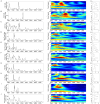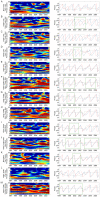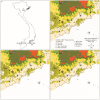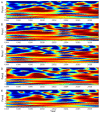Dengue dynamics in Binh Thuan province, southern Vietnam: periodicity, synchronicity and climate variability
- PMID: 20644621
- PMCID: PMC2903474
- DOI: 10.1371/journal.pntd.0000747
Dengue dynamics in Binh Thuan province, southern Vietnam: periodicity, synchronicity and climate variability
Abstract
Background: Dengue is a major global public health problem with increasing incidence and geographic spread. The epidemiology is complex with long inter-epidemic intervals and endemic with seasonal fluctuations. This study was initiated to investigate dengue transmission dynamics in Binh Thuan province, southern Vietnam.
Methodology: Wavelet analyses were performed on time series of monthly notified dengue cases from January 1994 to June 2009 (i) to detect and quantify dengue periodicity, (ii) to describe synchrony patterns in both time and space, (iii) to investigate the spatio-temporal waves and (iv) to associate the relationship between dengue incidence and El Niño-Southern Oscillation (ENSO) indices in Binh Thuan province, southern Vietnam.
Principal findings: We demonstrate a continuous annual mode of oscillation and a multi-annual cycle of around 2-3-years was solely observed from 1996-2001. Synchrony in time and between districts was detected for both the annual and 2-3-year cycle. Phase differences used to describe the spatio-temporal patterns suggested that the seasonal wave of infection was either synchronous among all districts or moving away from Phan Thiet district. The 2-3-year periodic wave was moving towards, rather than away from Phan Thiet district. A strong non-stationary association between ENSO indices and climate variables with dengue incidence in the 2-3-year periodic band was found.
Conclusions: A multi-annual mode of oscillation was observed and these 2-3-year waves of infection probably started outside Binh Thuan province. Associations with climatic variables were observed with dengue incidence. Here, we have provided insight in dengue population transmission dynamics over the past 14.5 years. Further studies on an extensive time series dataset are needed to test the hypothesis that epidemics emanate from larger cities in southern Vietnam.
Conflict of interest statement
The authors have declared that no competing interests exist.
Figures





Similar articles
-
ENSO-driven climate variability promotes periodic major outbreaks of dengue in Venezuela.Sci Rep. 2018 Apr 10;8(1):5727. doi: 10.1038/s41598-018-24003-z. Sci Rep. 2018. PMID: 29636483 Free PMC article.
-
Nonstationary influence of El Niño on the synchronous dengue epidemics in Thailand.PLoS Med. 2005 Apr;2(4):e106. doi: 10.1371/journal.pmed.0020106. Epub 2005 Apr 26. PLoS Med. 2005. PMID: 15839751 Free PMC article.
-
Spatiotemporal dynamics of dengue epidemics, southern Vietnam.Emerg Infect Dis. 2013 Jun;19(6):945-53. doi: 10.3201/eid1906.121323. Emerg Infect Dis. 2013. PMID: 23735713 Free PMC article.
-
Impacts of El Niño Southern Oscillation on the dengue transmission dynamics in the Metropolitan Region of Recife, Brazil.Rev Soc Bras Med Trop. 2022 Jun 6;55:e0671. doi: 10.1590/0037-8682-0671-2021. eCollection 2022. Rev Soc Bras Med Trop. 2022. PMID: 35674563 Free PMC article.
-
Review article. Studying climate effects on ecology through the use of climate indices: the North Atlantic Oscillation, El Niño Southern Oscillation and beyond.Proc Biol Sci. 2003 Oct 22;270(1529):2087-96. doi: 10.1098/rspb.2003.2415. Proc Biol Sci. 2003. PMID: 14561270 Free PMC article. Review.
Cited by
-
Using heterogeneous data to identify signatures of dengue outbreaks at fine spatio-temporal scales across Brazil.PLoS Negl Trop Dis. 2021 May 21;15(5):e0009392. doi: 10.1371/journal.pntd.0009392. eCollection 2021 May. PLoS Negl Trop Dis. 2021. PMID: 34019536 Free PMC article.
-
Spatiotemporal analysis of historical records (2001-2012) on dengue fever in Vietnam and development of a statistical model for forecasting risk.PLoS One. 2019 Nov 27;14(11):e0224353. doi: 10.1371/journal.pone.0224353. eCollection 2019. PLoS One. 2019. PMID: 31774823 Free PMC article.
-
The Influence of Spatial Configuration of Residential Area and Vector Populations on Dengue Incidence Patterns in an Individual-Level Transmission Model.Int J Environ Res Public Health. 2017 Jul 15;14(7):792. doi: 10.3390/ijerph14070792. Int J Environ Res Public Health. 2017. PMID: 28714879 Free PMC article.
-
Hot spot detection and spatio-temporal dispersion of dengue fever in Hanoi, Vietnam.Glob Health Action. 2013 Jan 24;6:18632. doi: 10.3402/gha.v6i0.18632. Glob Health Action. 2013. PMID: 23364076 Free PMC article.
-
Climate change and human health in Vietnam: a systematic review and additional analyses on current impacts, future risk, and adaptation.Lancet Reg Health West Pac. 2023 Nov 15;40:100943. doi: 10.1016/j.lanwpc.2023.100943. eCollection 2023 Nov. Lancet Reg Health West Pac. 2023. PMID: 38116497 Free PMC article. Review.
References
-
- Beatty M, Letson W, Edgil D, Margolis H. Estimating the total world population at risk for locally acquired dengue infection. Abstract presented at the 56th Annual Meeting of the American Society of Tropical Medicine and Hygiene. Am J Trop Med Hyg. 2007;77(Suppl 5):170–257. - PubMed
-
- Harrington LC, Edman JD, Scott TW. Why do female Aedes aegypti (Diptera: Culicidae) feed preferentially and frequently on human blood? J Med Entomol. 2001;38:411–422. - PubMed
-
- Scott TW, Amerasinghe PH, Morrison AC, Lorenz LH, Clark GG, et al. Longitudinal studies of Aedes aegypti (Diptera: Culicidae) in Thailand and Puerto Rico: blood feeding frequency. J Med Entomol. 2000;37:89–101. - PubMed
-
- World Health Organization and the Special Programme for Research and Training in Tropical Diseases. Dengue: guidelines for diagnosis, treatment, prevention and control - New edition. 2009 - PubMed
Publication types
MeSH terms
Grants and funding
LinkOut - more resources
Full Text Sources
Medical
Miscellaneous

